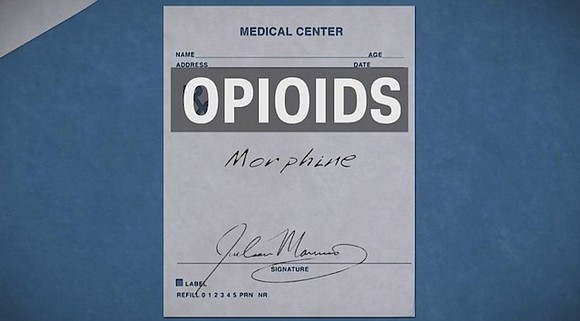Why Anti-opioid Protesters Littered a Legendary New York Art Space with Pill Bottles
CNN/Stylemagazine.com Newswire | 3/12/2018, 11:25 a.m.
By AJ Willingham, CNN
(CNN) -- On Saturday, orange and white pill bottles floated by the hundreds in the reflecting pool in front of the iconic Temple of Dendur in New York City's Metropolitan Museum of Art.
At first glance, the Sackler Wing at the famed art museum may seem a strange place for an anti-opioid demonstration, but protesters there wanted to call to attention the link between the wing's donors and the ongoing opioid crisis in America.
The wing was funded in the 1970s by a multi-million-dollar donation from the three Sackler brothers -- Arthur, Mortimer and Raymond. The brothers used their fortune from the pharmaceutical and medical advertising industries to become prominent art philanthropists. The Sacklers bought a pharmaceutical company that became Purdue Pharma, which developed the drug Oxycontin, which is a commonly abused painkiller and one of the main drugs cited in the ongoing prescription opioid crisis in the US.
So, to those who have seen the ravages of opioid addiction up close or personally, the Sacklers are inextricably tied to the drug's influence.
Saturday's protest, which involved a few dozen people, was started by Nan Goldin, a famous photographer who is also a survivor of opioid abuse -- specifically Oxycontin. As she and a few dozen protesters threw bottles into the pool, she cried "Shame!" and "Sacklers lie, people die" as a banner reading "Fund Rehab" was displayed nearby.
"The Sacklers made their fortune promoting addiction," Goldin wrote in Artforum magazine in 2017. "OxyContin is one of the most addictive painkillers in the history of pharmacology. They advertised and distributed their medication knowing all the dangers. The Sackler family and their private company, Purdue Pharma, built their empire with the lives of hundreds of thousands."
Goldin started a group called P.A.I.N. (Prescription Addiction Intervention Now) that has taken on the Sackler family and Purdue Pharma as a main focus of their activism. Among the group's goals are the funding of treatment models and educational programs for schools, doctors and addicts, as well as the request that Purdue Pharma "introduce effective labeling of their products and the addiction potential," and "advertise the dangers of their products as aggressively as they sold them to the public."
Goldin and members of her group also want museums and galleries to reject further donations from the Sacklers.
In response, Purdue Pharma has said they are committed to fighting the opioid epidemic.
"We are deeply troubled by the prescription and illicit opioid abuse crisis, and we are dedicated to being part of the solution," reads a statement provided by Bob Josephson, Purdue Pharma's executive director of communications.
"Purdue's led industry efforts to combat prescription drug abuse which includes collaborating with law enforcement, funding state prescription drug monitoring programs and directing health care professionals to the CDC's Guideline for Prescribing Opioids for Chronic Pain. In addition, we've recently announced educational initiatives aimed at teenagers warning of the dangers of opioids and continue to fund grants to law enforcement to help with accessing naloxone."
Purdue Pharma's website also opens with a letter regarding their relationship to the ongoing crisis.
"We manufacture prescription opioids," the letter begins. "How could we not help fight the prescription and illicit opioid abuse crisis?"
CNN has reached out to the Metropolitan Musem of Art for comment and is waiting to hear back.




